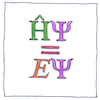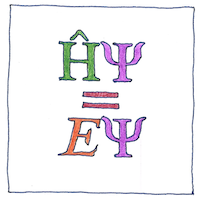Erwin Schrödinger
quantum mechanics

|
Schrödinger equation
If a thing could be a wave or a particle then a classical trajectory cannot describe it. Erwin Schrödinger derived an equation for how a wave function changes over time.
The operation of time is unitary
Time changes each thing independently. See how quickly the system processes each quantum of energy, its potential, its mass, and the momentums of all its possible paths. Multiple things in a system affect each other. This could be a contraction, or time always operates on the system, or we have stopped thinking of mere time. Time operates on the system because multiple particles acting together have only one wave function.
Multiples
Multiple interpretations, multiple solutions, and multiple implications of which multiple universes and multiple multiplications are possible and possibly probable.



I have illustrated the time-independent Schrödinger equation because it is simpler. The time-dependent Schrödinger equation is more explicit about space and time:
See also in The book of science:
Readings in wikipedia: